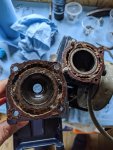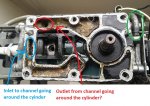chrisparr
New Member
Hello all,
I ran my outboard for the first time the other week and noticed there wasn't any water coming out of the exhaust port on the leg just by the mounting bracket. I've seen many videos and comments on this forum that you should see water there.
So I've taken it apart and boy were the channels in the exhaust plate (if that what it's called?) between the leg and power head clogged up. Cleaned all of this out, and reassembled with new impeller and gaskets. Started it up today and still no water exiting the port.
Hmmm. So I broke this down Pulled the power head off, stuck the leg is a wheelie bin full of water with a drill connected to the drive shaft and it does pump water up the pipe. A steady flow.
I then wondered if it was the port clogged up. I can feel exhaust gas exit, but you never know, so I stuck the hose pipe down the leg intending to fill it up to see if water flowed..... the only problems is it didn't fill up enough to reach the port. There is ample room for water to flow out of the leg above the gearbox at the bottom of the leg. I'm pretty sure the engine can't pump water at a greater rate than the hose, so I wouldn't expect to see water exit at the port.... but why do I see videos of this and people commenting that we should see water at the port.
Confused. What I'm going to do next is take the power head and put water manually down where it would be pumped in and see if it flows out where it should without issue. if that is the case I think I can put it back together and I'm good.
I'm just very confused as to why everyone else's Yamaha/Mariner 2B that I've seen in video's behaves differently.
Any thoughts?
I ran my outboard for the first time the other week and noticed there wasn't any water coming out of the exhaust port on the leg just by the mounting bracket. I've seen many videos and comments on this forum that you should see water there.
So I've taken it apart and boy were the channels in the exhaust plate (if that what it's called?) between the leg and power head clogged up. Cleaned all of this out, and reassembled with new impeller and gaskets. Started it up today and still no water exiting the port.
Hmmm. So I broke this down Pulled the power head off, stuck the leg is a wheelie bin full of water with a drill connected to the drive shaft and it does pump water up the pipe. A steady flow.
I then wondered if it was the port clogged up. I can feel exhaust gas exit, but you never know, so I stuck the hose pipe down the leg intending to fill it up to see if water flowed..... the only problems is it didn't fill up enough to reach the port. There is ample room for water to flow out of the leg above the gearbox at the bottom of the leg. I'm pretty sure the engine can't pump water at a greater rate than the hose, so I wouldn't expect to see water exit at the port.... but why do I see videos of this and people commenting that we should see water at the port.
Confused. What I'm going to do next is take the power head and put water manually down where it would be pumped in and see if it flows out where it should without issue. if that is the case I think I can put it back together and I'm good.
I'm just very confused as to why everyone else's Yamaha/Mariner 2B that I've seen in video's behaves differently.
Any thoughts?


